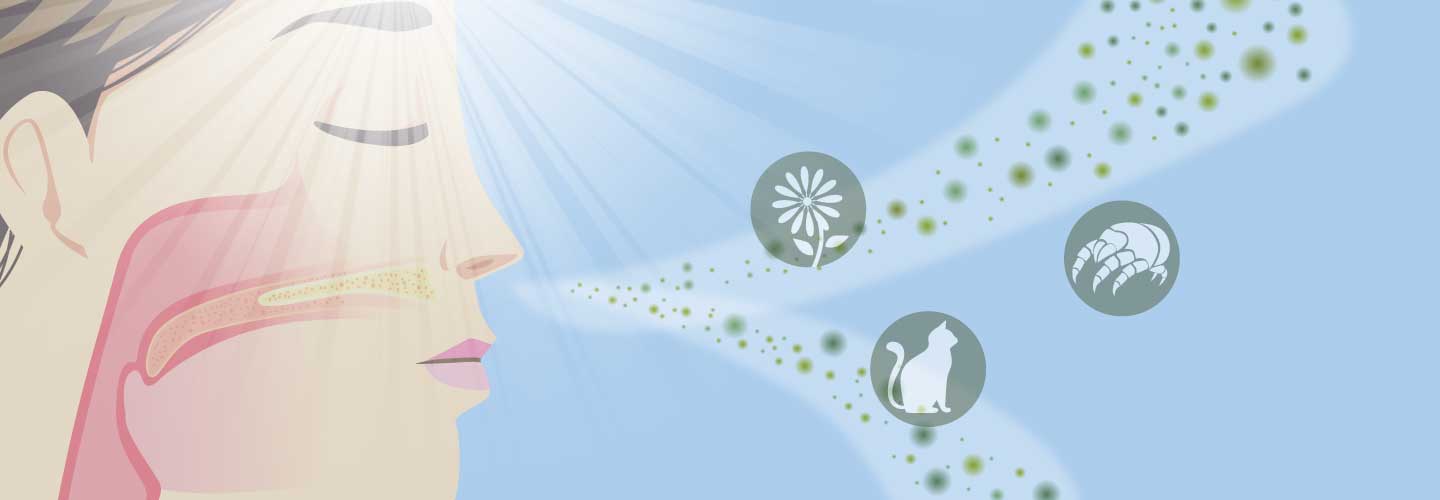

Inflammation of the nasal mucous membrane is called rhinitis. The symptoms include sneezing and runny and/or itchy nose, caused by irritation and congestion in the nose. There are two types: allergic rhinitis and non-allergic rhinitis. Allergic Rhinitis occurs when the body's immune system over-responds to specific, non-infectious particles such as plant pollens, molds, dust mites, animal hair, industrial chemicals (including tobacco smoke), foods, medicines, and insect venom. During an allergic attack, antibodies, primarily immunoglobin E (IgE), attach to mast cells (cells that release histamine) in the lungs, skin, and mucous membranes. Once IgE connects with the mast cells, a number of chemicals are released. One of the chemicals, histamine, opens the blood vessels and causes skin redness and swollen membranes. When this occurs in the nose, sneezing and congestion are the result.
Seasonal allergic rhinitis or hayfever occurs in the spring and fall typically. Hypersensitivity to ragweed is the primary cause of seasonal allergic rhinitis in 70 percent of all Americans who suffer from this seasonal disorder. People with sensitivity to tree pollen have symptoms in late spring; an allergic reaction to mold spores occurs in October and November as a consequence of falling leaves.
Perennial allergic rhinitis occurs year-round and can result from sensitivity to pet hair, mold on wallpaper, dust, cockroaches, houseplants, carpeting, and upholstery. Some studies suggest that air pollution such as automobile engine emissions can aggravate allergic rhinitis. Patients who suffer from recurring bouts of allergic rhinitis should observe their symptoms on a continuous basis. Perennial allergens may even molds which are ubiquitous and lead to greater hypersensitivities that may induce or perpetuate progression to sinusitis (inflammation of the sinuses outside the nose).
Non-Allergic Rhinitis does not depend on the presence of IgE and is not due to an allergic reaction. The symptoms can be triggered by cigarette smoke and other pollutants as well as strong odors, alcoholic beverages, and cold. This can also include overuse of medications such as oxymetazoline or phenylephrine nasal sprays. As well, elderly people will sometimes develop an aging related rhinitis called vasomotor rhinitis that is exacerbated by meals and activity. Vasomotor rhinitis is a unique case of rhinitis that may actually have a surgical treatment option called Clarifix. Clarifix is performed by using cryotherapy to ablate the nerves that lead to the uncontrolled secretions and rhinorrhea from the nose causing rhinitis symptoms. Other causes of symptoms that may mimic rhinitis include blockages in the nose, a deviated septum, turbinate hypertrophy and polyps. These can also be treated by Dr. Kelsch to help improve nasal breathing.
Call and make an appointment today, and take the first steps to a dry and more open nose.
Recent research has better defined the association between rhinitis and sinusitis. They have concluded that sinusitis is often preceded by rhinitis and rarely occurs without concurrent rhinitis. The symptoms include nasal obstruction, nasal discharge, loss of smell, and occur with a high frequency in both disorders. Most importantly, computed tomography (CT scan) findings have established that the mucosal linings of the nose and sinuses are simultaneously involved in the common cold (previously, thought to affect only the nasal passages). Otolaryngologists, acknowledging the inter-relationship between the nasal and sinus passages, now refer to sinusitis as rhinosinusitis.
The catalyst relating the two disorders is thought to involve nasal sinus overflow obstruction, followed by bacterial colonization and infection leading to acute, recurrent, or chronic sinusitis. Likewise, chronic inflammation due to allergies can lead to obstruction and subsequent sinusitis.
Copyright © 2026
Website by Red Advertising